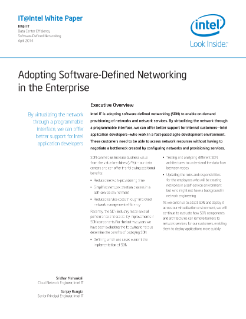Network Provisioning: Now with Self-Service
Intel IT is adopting software-defined networking (SDN) to enable on-demand provisioning of networks and network services. By virtualizing the network through a programmable interface, we can offer better support for internal customers—Intel application developers—who work in a fast-paced agile development environment. These customers need to be able access network resources without having to negotiate a bottleneck created by configuring networks and provisioning services.
SDN can help us increase business value from the virtual machines (VMs) in our data centers and can offer the following additional benefits:
- Reduced network-provisioning time
- Simplified network creation process in a self-service environment
- Reduced service costs through improved network management efficiency
Recently, the SDN industry made several performance and scalability improvements in SDN components. For the last two years we have been evaluating the following to help us determine the benefits of deploying SDN:
- Defining which use cases warrant the implementation of SDN
- Testing and analyzing different SDN architectures to understand the data flow between nodes
- Updating the roles and responsibilities for the employees who will be creating networks in a self-service environment but who might not have a background in network engineering
As we continue to adopt SDN and deploy it across our virtualization environment, we will continue to evaluate how SDN components and architectures can remove barriers to network services for our customers, enabling them to deploy applications.
Read the full Adopting Software-Defined Networking in the Enterprise White Paper.
